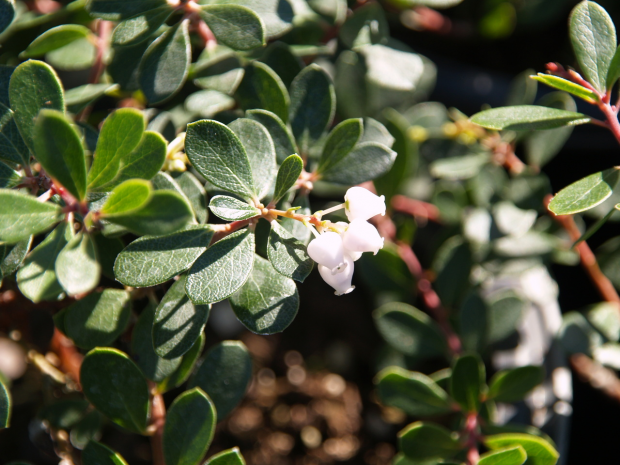Emerald Carpet Manzanita is an evergreen thick shrub that grows on the ground. It gives the landscape a very wonderful and gentle texture that is used to its full potential. This shrub requires low maintenance and pruning after flowering. It attracts birds, bees, and butterflies but not deer, who prefer richer meals. It doesn’t have any substantial drawbacks. The Emerald Carpet Manzanita is ideal for border edging, groundcover accent, and mass planting.
Late in the winter until early in the spring, the Emerald Carpet Manzanita displays the most attractive nodding bell-shaped flowers in a pure white color at the tips of its branches. It possesses lovely dark green foliage that transforms into a lighter green color in the spring. The small, shiny, oval leaves of this emerald carpet manzanita are very pretty and stay dark green all winter long. From the middle of summer till the end, it bears crimson berries.
Emerald Carpet Manzanita Growth Rate
At maturity, the Emerald Carpet Manzanita is around 12 inches tall with a spread of 4 feet. For this reason, it does not necessarily need to be surrounded by other plants in front of it. It grows slowly and is anticipated to last roughly 30 years under ideal conditions. It needs twice-monthly irrigation throughout the dry season once established. Less water is required in partially shaded areas.
Manzanita prefers well-drained soil and full light. It is resistant to insects and diseases, requires little fertilization, and produces little white or pink blooms in early spring, followed by berries. Despite the large variety of low-growing manzanitas found in nature, there are only a few that thrive in gardens. There is a multitude of manzanita varieties ranging from ground coverings to small trees. Manzanitas are excellent wildlife plants that are often as strong as nails. They thrive in extremely arid environments. Most manzanitas die without good drainage.
Emerald Carpet Manzanita Problems
In some cases, Manzanitas are infected with a fungus that causes branches to die back. In addition, they are susceptible to microbial leaf spots, wood borers, and aphid galls. If the disease is suspected in the garden, avoid watering from above, remove dead branches, and remove falling leaves. The manzanita plant possesses two fascinating adaptations to its surroundings.
A significant number of manzanitas possess a burl at the ground surface, and following a wildfire, new shoots emerge from this burl. Whiteleaf Manzanita seeds are able to germinate when they are exposed to heat and charcoal from a fire.
This plant, like the vast majority of others in its genus, cannot survive in soils with poor drainage. On the other hand, it is able to tolerate significantly more moisture than the majority of other manzanita species, and it grows and thrives in moderately dense soil. Furthermore, it is resistant to the common leaf spot problems that strike most members of this species when subjected to typical summer irrigation levels.
Emerald Carpet Manzanita Care
Emerald Carpet’ is perhaps the most popular among landscapers due to its incredibly dense, lush, emerald glossy foliage, elegant stems, and white blooms in early spring. If ‘Emerald Carpet’ begins to yellow, nitrogen fertilizer is required. Planting in October when the rains start and the soil is warm helps create a robust root system. ‘Emerald Carpet’ benefits from twice-monthly irrigation after it is established. This shrub does well in conditions ranging from full sun to light shade. It tolerates dry and damp conditions, but not standing water.
Manzanitas require relatively little care in the garden. The majority of Manzanitas are drought-tolerant, requiring just infrequent watering and not standing water. During the first year of their life in the garden, make sure to give the plants plenty of water, but once they are established, cut back to once a month or less. Acidic or neutral soil, not alkaline, is required for good drainage. Manzanitas enjoy the sun, but some grow in moderate shade. It is recommended to plant them away from other plants to allow for optimum air circulation and to allow for their maximum size.
Emerald Carpet Manzanita Propagation
Manzanitas do not require pruning, although pinching the tops of branches after their blooms fade encourages branching below them and helps them grow more quickly. It is best to prune in the summer, when the wounds dry and heals rapidly and latent buds do not grow. Cuttings or layering, rather than seed, are the easiest ways to propagate these plants. In the summer, semi-ripe cuttings are also used to propagate this plant.



